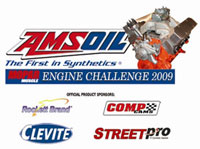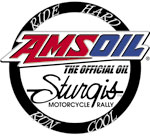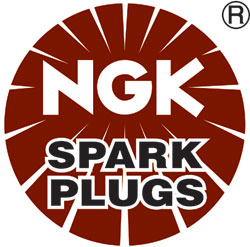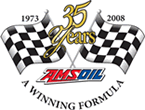AMSOIL vs Royal Purple
In a head to head test of AMSOIL vs Royal Purple who comes out on top?
As you already know this is a very touchy subject. There are a few topics you should never bring up at your family holiday party. Those topics are religion, politics, and what motor oil you should use.
A lot of emotion gets tied up in a mans choice of motor oil. Even though we believe we are making a purely logical decision on what to protect our engines with the truth is there is very little science applied.
The first oil change I ever performed on my 1971 Buick Skylark with the 350 four barrel was the same oil my Dad had been using for years... Is that scientific? Not hardly.
Now that I am a degreed and licensed Mechanical Engineer I have an appreciation for the American Society of Testing and Materials (ASTM). These standards are essential to producing consistent materials by specifying minimum and maximum requirements and testing methodology.
If we are truly going to use logic instead of emotion to select between AMSOIL and royal purple then there is nothing more important than third party laboratory bench testing conducted in accordance the American Society of Testing and Materials (ASTM). We will use ASTM standard tests to make a comparison of AMSOIL vs Royal Purple.
Here are the test results along with some simple explanations of the significance of the results.
Four Ball Wear Test
The "four ball wear test" is a great way to separate the men from the boys. This is the test where the lab will press and spin a metal ball down into three other balls arranged in a triangle.
This is done in a bath of the oil being tested. The better the oil protects then the less damage that happens.
The smaller the wear scar the better...
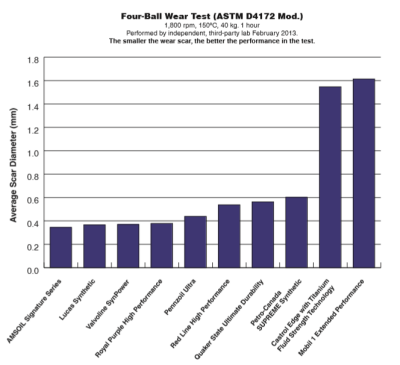
As you can see the AMSOIL signature series is all the way to the left in first place with the smallest wear scar where Royal Purple came in 4th place.
Generally speaking they are very close in this test but motor oil is like a chain in that it is only as strong as its weakest link.
Cold Cranking Viscosity Test
Most of your engine wear occurs right when you start your vehicle. You need to get your oil flowing instantly to minimize wear.
As you can imagine the thicker your oil is when it is cold the longer it takes for your oil pump to get the oil up through your engine.
The lower the number the better.
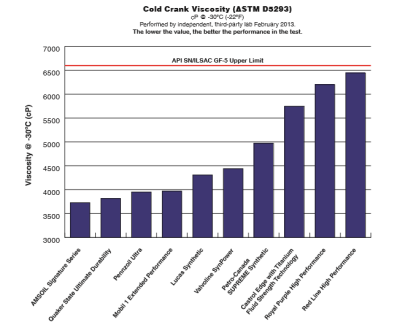
As you can see Royal Purple is second to last in the cold crank viscosity test where AMSOIL placed first.
One of the great benefits of using synthetic oils is supposed to be the low temperature performance so you would expect to see synthetic oils perform very well on this test yet there are some surprising results.
NOACK Volatility Test
The NOACK test demonstrated how much an oil evaporates under high temperature service.
If oil evaporates inside your engine it will burn off in the cylinders or through positive crankcase ventilation system. This will show up as oil consumption.
When your oil evaporates the oil that is left has different properties and will not protect your engine as well.
The lower the number the better.
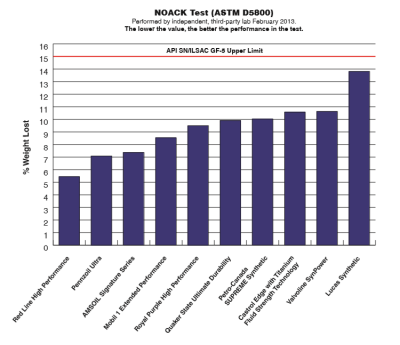
Thermo-Oxidation Engine Oil Simulation Test or TEOST Test
Engine oils form deposits when the are burned off under high heat. This happens on your fuel injectors, on turbos, and other high temperature areas.
Small deposits on fuel injectors reduce combustion efficiency by altering the injectors spray pattern. It is surprising how much this will effects your engine power.
The bottom line is you want an oil that does not burn off and when it does it leaves very little deposit.
In the test results below the lower number the better.
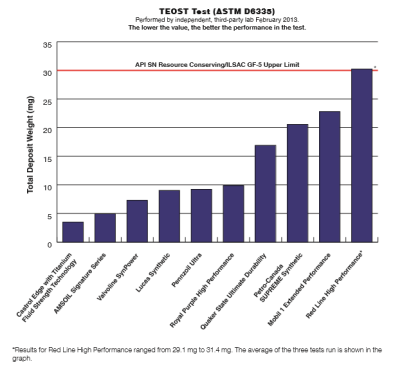
Total Base Number Test
Acid corrosion inside your engine would quickly destroy important clearances and reduce performance if it were not for the reserve alkalinity in your motor oil.
TBN is a measure of how well an oil will control the acids formed inside your engine.
The higher the TBN number the better.
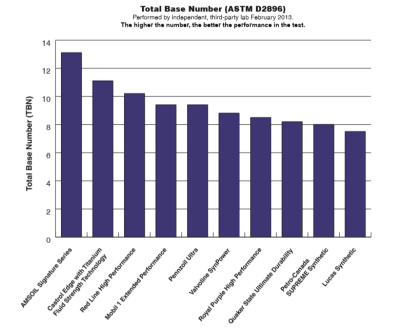
The higher the TBN number the better able an oil will protect your engine for longer periods. You can see who takes first in an AMSOIL vs royal purple comparison.
Which Oil Protects Best and Saves You Money?
AMSOIL signature series synthetic motor oil is recommended for 25,000 miles or one year of service under normal service.
Out of all the oils tested AMSOIL is the only oil that can be changed just once per year where all the other oils would require an oil change a little more than twice per year based on an annual average mileage of 11,318.
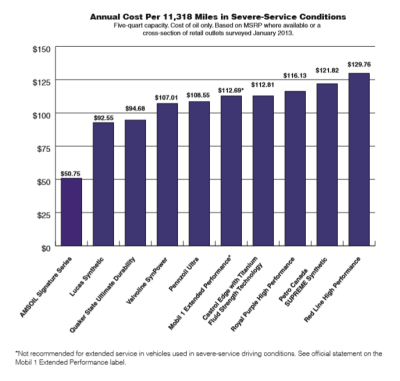
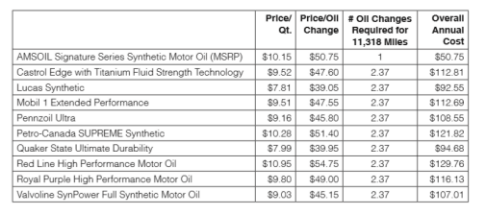
Conclusion
As you can see in a comparison of AMSOIL vs Royal Purple that AMSOIL stands out front.
You can have confidence in these results because the test were conducted by a third party independent lab. Samples were taken in random order and were coded to eliminate bias. The lab did not know which oil was from which manufacturer.
How to get a good discount when you buy AMSOIL
If you like what you see here and you are wondering where can I buy AMSOIL or how to order AMSOIL. Follow those links for some information on taking the next steps to better engine protection and increased performance.

